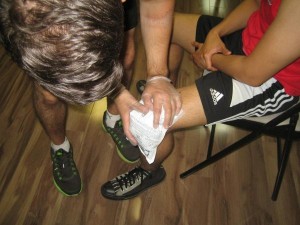A bruised knee results to pain and evident discoloration in the kneecap. The injury typically occurs after sustaining a direct blow or strike to the kneecap. This is likely to occur from falling onto the joint or being struck by a hard or solid object.
What are the signs?
- Knee pain
- Aching sensation under the kneecap
- Swollen knee
- Difficulty or discomfort when walking or running
- The exterior of the knee might swell if the bursa is bruised
Management of a bruised knee

If an individual sustained a bruised knee, the following measures can help:
- Apply an ice pack or pack of frozen vegetables that has been wrapped by a clean cloth or towel on the site of injury every 3-4 hours at 20 minutes at a time until the discomfort and swelling settles.
- The affected knee must be raised on a cushion or pillow while sitting or lying down.
- Pain medications can be taken but carefully follow the instructions given by the doctor.
- Crutches must be used if needed.
During the recovery period, the individual should change activity or sport so that the injury is not aggravated.
The effects of a bruised knee can last for several days to weeks or even longer. It might take a longer time to recuperate if the rear part of the patella is damaged.
Most cases of the injury are brought about by accidents that could not be prevented. If engaging in certain sports that require knee protection, make sure that the equipment correctly fits.
